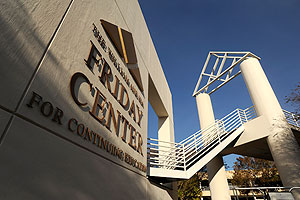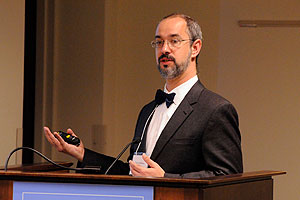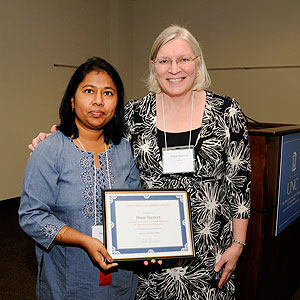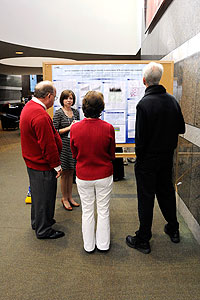GEMS reflects on 30 years
By Ernie Hood

GEMS held its fall 2012 meeting at the William and Ida Friday Center for Continuing Education in Chapel Hill, N.C. (Photo courtesy of Steve McCaw)

GEMS President Keshava presided over the day’s activities at the society’s 30th annual meeting, which included several scientific presentations, student and postdoc posters, the awarding of certificates of appreciation to GEMS past presidents, and election of new officers. (Photo courtesy of Steve McCaw)

Balshaw stressed the interdisciplinary nature of emerging exposure science, saying “Everything from engineering sciences, such as electrical engineering and environmental engineering, to computational sciences to handle the data, to environmental epidemiology and toxicology, are critically involved, as well as the clinical side to understand the health relevance of the data.” (Photo courtesy of Steve McCaw)
The Genetics and Environmental Mutagenesis Society (GEMS) celebrated its 30th anniversary Nov. 8, by recognizing the contributions of its 27 past presidents and showcasing the research of several students and postdocs. At the fall 2012 meeting, held at the William and Ida Friday Center for Continuing Education in Chapel Hill, N.C., GEMS members looked back on three decades of success in developing a thriving, local forum for genetics and environmental mutagenesis students, postdocs, and senior researchers.
The meeting and slate of speakers were organized by GEMS President Nagu Keshava, Ph.D., of the U.S. Environmental Protection Agency (EPA), around the theme of “Air Quality and Health Impacts.”
“We were trying to have a transdisciplinary theme this time, incorporating the environmental aspect,” said Keshava.
She also noted that when the society was founded in 1982, many of its members could not afford to attend large national meetings and, due to the current economic climate and federal government budget tightening, the same impediment remains. Keshava said that GEMS has allowed local students and postdocs to attend a meeting in their discipline, with excellent speakers and the opportunity to establish connections and potential collaborations.
Three main speakers were featured over the course of the daylong meeting. The first speaker, David Balshaw, Ph.D., program administrator in the NIEHS Division of Extramural Research and Training, addressed the approximately 60 attendees on “Emerging Technologies for Exposure Assessment: Making the Exposome a Reality” (see text box).
GEMS members were also treated to presentations by EPA health scientist Lucas Neas, Ph.D., who spoke about “Air Pollution Epidemiology in a Multipollutant World,” and Jason West, Ph.D., of the Department of Environmental Sciences and Engineering at the University of North Carolina at Chapel Hill (UNC), whose talk addressed “Connecting Climate, Air Quality, and Human Health: Applications Using Global Atmospheric Models.”
EPA and UNC School of Medicine postdoctoral fellow Esra Mutlu, Ph.D., shared the results of her group’s research on the “Comparative Mutagenicity of Diesel and Biodiesel Emissions,” which found that, under the study’s conditions, emissions from biodiesel combustion were less mutagenic than those from petroleum diesel.
Student awards for posters went to Ryan Thys of the Wake Forest School of Medicine and Jennifer Nichols, a predoctoral IRTA fellow in the NIEHS Laboratory of Respiratory Biology. Nichols won the society’s GEMS Award for her abstract, “Chrm2 Is a Candidate Susceptibility Gene for Hyperoxic Lung Injury in a Murine Model of Bronchopulmonary Dysplasia.”
GEMS also conducted its annual business meeting, marked by the election of new officers, including President-elect William Kauffman, Ph.D., of the UNC Department of Pathology and Laboratory Medicine.
(Ernie Hood is a contract writer for the NIEHS Office of Communications and Public Liaison.)

NIEHS/NTP health scientist Diane Spencer was one of the society’s past presidents who received a certificate of appreciation from current GEMS President Keshava. Spencer led the group 2002-2003. (Photo courtesy of Steve McCaw)

NIEHS predoctoral IRTA fellow Jennifer Nichols discussed her GEMS award-winning poster. (Photo courtesy of Steve McCaw)
New tools for analyzing the exposome
In his presentation at the GEMS meeting, Balshaw provided an overview of the new tools and emerging approaches that promise fresh insights into the exposome — the measure of all the exposures of an individual in a lifetime and how those exposures relate to health.
Among the many innovative methods developed through NIEHS funding, several new devices for monitoring exposures to airborne pollutants are poised to provide valuable information about exposure risks. Balshaw observed that after years of development, some are close to full deployment, but significant challenges remain.
“The data is very different from what we’re getting from existing technologies,” he said. “It’s both a much larger data volume, and much more complex type of exposure data than what the epidemiologists are used to working with.”
Balshaw told the GEMS attendees that, eventually, the goal is to determine untargeted associations between environment and disease. “The ultimate future is to look at global changes in both genetic factors and environmental factors, so that you can truly begin to understand individual risk of developing diseases and the factors that contribute to susceptibility.”
"This month in EHP ..." - previous story ![]()
![]() next story - "Extramural papers of the ..."
next story - "Extramural papers of the ..."
December 2012 Cover Page


